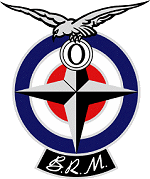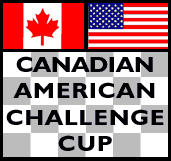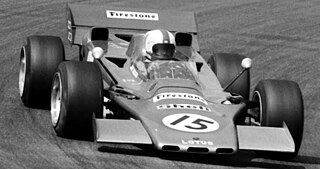
Sir John Young Stewart OBE is a British former Formula One racing driver from Scotland. Nicknamed the "Flying Scot", he competed in Formula One between 1965 and 1973, winning three World Drivers' Championships and twice finishing as runner-up over those nine seasons. He was the only British driver to win three championships until Lewis Hamilton in 2015.
The Surtees Racing Organisation was a race team that spent nine seasons as a constructor in Formula One, Formula 2, and Formula 5000.

British Racing Motors (BRM) was a British Formula One motor racing team. Founded in 1945 and based in the market town of Bourne in Lincolnshire, it participated from 1951 to 1977, competing in 197 grands prix and winning seventeen. BRM won the constructors' title in 1962 when its driver Graham Hill became world champion. In 1963, 1964, 1965 and 1971, BRM came second in the constructors' competition.

Brands Hatch is a motor racing circuit in West Kingsdown, Kent, England, United Kingdom. Originally used as a grasstrack motorcycle circuit on farmland, it hosted 12 runnings of the British Grand Prix between 1964 and 1986 and currently hosts many British and International racing events. The venue is owned and operated by Jonathan Palmer's MotorSport Vision organisation.

Karl Jockum Jonas "Joakim" Bonnier was a Swedish sportscar racing and Formula One driver who raced for various teams. He was the first Swede to both enter and win a Formula One Grand Prix.

Pedro Rodríguez de la Vega was a Mexican racing driver. He began his Formula One career in 1963, won the 1967 South African Grand Prix in a Cooper and the 1970 Belgian Grand Prix in a BRM. He was the older brother of Ricardo Rodríguez.

Joseph Siffert was a Swiss racing driver.

Jean-Pierre Maurice Georges Beltoise was a French Grand Prix motorcycle road racer and Formula One driver who raced for the Matra and BRM teams. He competed in 88 Grands Prix achieving a single victory, at the 1972 Monaco Grand Prix, and a total of eight podium finishes.

Peter Westbury was a British racing driver from England. He participated in two World Championship Formula One Grands Prix, scoring no championship points. In 1969 he raced a Formula 2 Brabham-Cosworth, driving in his first Grand Prix in the 1969 German Grand Prix. He finished ninth on the road, fifth in the F2 class. The following year he failed to qualify for the 1970 United States Grand Prix driving a works BRM, after an engine failure.

Vernon John Schuppan is a retired Australian motor racing driver. Schuppan drove in various categories, participating in Formula One, the Indianapolis 500 and most successfully in sports car racing.

Mark Neary Donohue Jr., nicknamed "Captain Nice," and later "Dark Monohue," was an American race car driver and engineer known for his ability to set up his own race car as well as driving it to victories.

Richard James David "Dickie" Attwood is a British motor racing driver from England. During his career he raced for the BRM, Lotus and Cooper Formula One teams. He competed in 17 World Championship Grands Prix, achieved one podium and scored a total of 11 championship points. He was also a successful sports car racing driver and won the 1970 24 Hours of Le Mans race, driving a Porsche 917, the first of Porsche's record 19 victories at the famous race.

The Canadian-American Challenge Cup, or Can-Am, was an SCCA/CASC sports car racing series from 1966 to 1974, and again from 1977 to 1987.

David Walker was an Australian racing driver who drove for Lotus in the 1971 and 1972 Formula One World Championships.
Four-wheel drive (4WD) has only been tried a handful of times in Formula One. In the World Championship era since 1950, only eight such cars are known to have been built.

Ecurie Bonnier, Ecurie Suisse, Joakim Bonnier Racing Team and Anglo-Suisse Racing Team were names used by Swedish racing driver Joakim Bonnier to enter his own cars in Formula One, Formula Two and sports car racing between 1957 and his death in 1972. Commonly the vehicles were entered for Bonnier himself, but he also provided cars for a number of other drivers during the period.

The Brabham BT3 is a Formula One racing car. It was the first Formula One design to be produced by Motor Racing Developments for the Brabham Racing Organisation, and debuted at the 1962 German Grand Prix. The Brabham BT3 was the vehicle with which team owner – then two-time World Champion – Jack Brabham, became the first driver ever to score World Championship points in a car bearing his own name, at the 1962 United States Grand Prix. The following year Brabham also became the first driver ever to win a Formula One race at the wheel of an eponymous car, again driving the BT3, at the 1963 Solitude Grand Prix. The BT3 design was modified only slightly to form the Tasman Series-specification Brabham BT4 cars.
Michael Roy Pilbeam is a British motorsport designer and engineer known for his work with BRM, Lotus, Surtees and his own company, Pilbeam Racing Designs. An early design was the experimental four wheel drive Formula One BRM P67 of 1964. As of 2014, Pilbeam's company continued to produce hillclimb cars and sports prototype chassis for endurance racing.
Anthony Gordon Dean was a British racing driver from England who competed in sports car racing, touring car racing, the Can-Am series and various single seat formulae, including non-championship Formula One, in the 1960s, 1970s, and 1980s. He is known for winning a round of the Can-Am championship in 1970 as a privateer entrant.

The BRM P167 is a purpose-built sports prototype race car, designed, developed and built by British Racing Motors to Group 7 racing specifications, specifically to compete in the Can-Am racing series, between 1971. It was BRM's final Can-Am race car chassis. It was powered by a naturally aspirated, Chevrolet big-block engine, developing a solid 600 hp (450 kW).
















